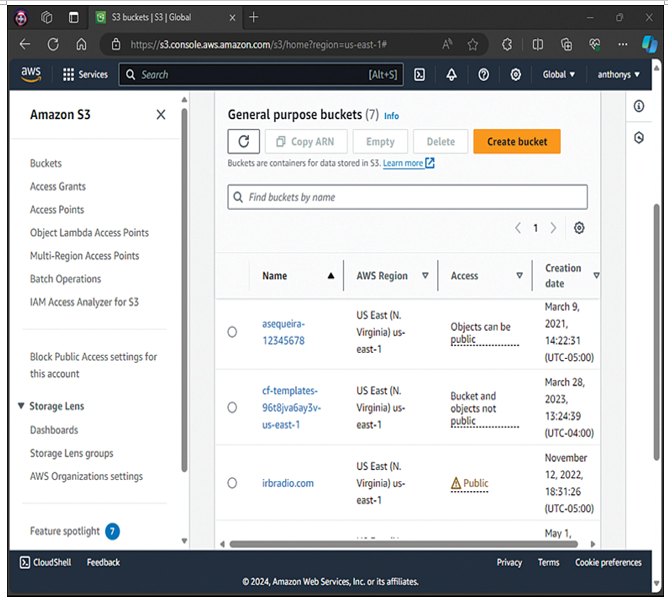Fundamental Storage Services
Companies today are creating massive amounts of data that needs to be stored. They are turning to block-based, file-based, and object-based storage solutions to try to keep up with their storage demands. AWS wants to be of assistance and offers many different cloud-based storage solutions covering the gamut of storage technologies. In this part of the chapter, we will examine three fundamental solutions in AWS: S3, EBS, and EFS.
Simple Storage Service (S3)
AWS Simple Storage Service (S3) is object storage with a simple web service interface to store and retrieve any amount of data from anywhere on the web. It is designed to deliver 99.999999999% durability. Figure 16-1 shows an example of storage buckets using S3.

Figure 16-1 AWS S3
You can use Amazon S3 for a vast number of purposes, such as the following:
Primary storage for cloud-native applications
A bulk repository, or “data lake,” for analytics
A target for backup and recovery
A target for disaster recovery purposes
With serverless computing
You can move large volumes of data into or out of S3 with AWS’s cloud data migration options. You can store data in S3 and then automatically tier the data into lower-cost, longer-term cloud storage classes like S3 Standard-Infrequent Access and Glacier for archiving. You can even use a newer storage class that reduces high availability (One Zone Infrequent Access) when you do not require high availability and want to save on storage costs. We cover the available S3 storage classes later in this section.
S3 offers many advantages, including the following:
Simple: S3 is easy to use, with a web-based management console and mobile app. Amazon S3 also provides full REST APIs and SDKs for easy integration with third-party technologies. A command-line interface (CLI) is also a popular option for working with S3.
Durable: S3 provides a durable infrastructure to store essential data. Amazon designed S3 for durability of 99.999999999% of objects. S3 redundantly stores your data across multiple facilities and multiple devices in each facility.
Scalable: With S3, you can store as much data as you want and access it when needed. While there is a 5 TB limit on the size of an individual object, there is no limit to the number of objects you can store.
Secure: S3 supports data transfer over SSL and automatic encryption of your data following the upload. If you want, you can control client-side or server-side encryption. You can use Amazon-generated or customer-generated keys and have full key management capabilities/options. You can also configure bucket policies to manage object permissions and control access to your data by using Identity and Access Management (IAM).
Available: S3 Standard is designed for high availability of objects and is backed by the Amazon S3 service-level agreement, ensuring that you can rely on it when needed. You can also choose an AWS Region to optimize for latency, minimize costs, or address regulatory requirements.
Low cost: S3 allows you to store large amounts of data at a small cost. Using lifecycle policies, you can configure the automatic migration of your data to different storage tiers within AWS.
Simple data transfer: Amazon provides multiple options for cloud data migration and allows you to easily and cost-effectively move large volumes of data into or out of S3. You can choose from network-optimized, physical disk-based, and third-party connector methods for import to or export from S3.
Integrated: S3 is deeply integrated with other AWS services to make it easier to build solutions that use a range of AWS services.
Easy to manage: S3 storage management features allow you to take a data-driven approach to storage optimization, data security, and management efficiency. These enterprise-class capabilities give you data about your data so that you can manage your storage based on that personalized metadata.
While technically part of the S3 service, Amazon Glacier is a secure, durable, and extremely low-cost storage service for data archiving and long-term backup. With Glacier, you can do the following:
Reliably store large or small amounts of data for as little as $0.004 per gigabyte per month.
Save money compared to on-premises storage options.
Keep costs low yet suitable for varying retrieval needs.
